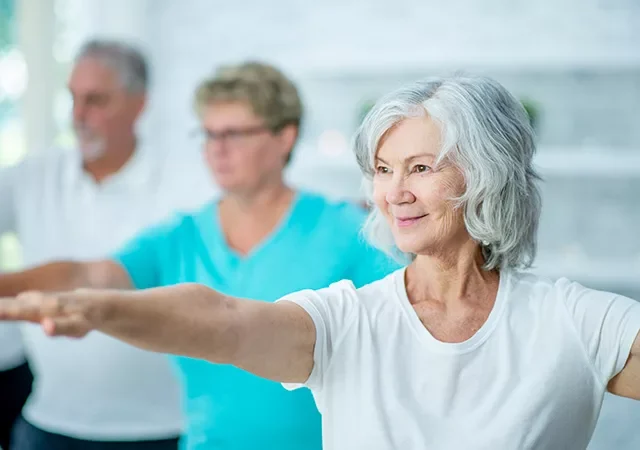What if there were a way to improve your memory, your mood and even your sleep-and didn’t require a pill, strenuous exercise or special equipment? Would you try it? For an increasing number of older Americans, the ancient practice of meditation offers these benefits and so much more. And nothing could be easier to work in to your daily routine.
There is evidence of meditation in ancient wall art dating back as far as 5,000 BCE, and it is incorporated in one way or another in virtually every major religion. You may remember when Transcendental Meditation (TM) burst onto the scene in the 60s and 70s, thanks to a boost by the Beatles, who traveled to India to study the practice. “The Relaxation Response,” a 1976 book by Dr. Herbert Benson which is still in print, explained some of the science behind meditation as well as its benefits. It is credited with moving the practice of meditation into the mainstream.
Today, the benefits of meditation are well-established, including long-lasting cognitive gains . This is especially meaningful for older people. Studies show the regular practice of meditation may not only offset typical age-related declines in cognition, but also enhance cognitive function. This means memory, attention, the speed of mental processing and executive functioning may all be improved by meditation. There also is evidence that the practice may slow the progress of Alzheimer’s disease. But improvements in mental functioning are only the start. Here are other benefits of spending 10 or 20 minutes each day in meditation:
Relaxation and stress relief
-Meditation has long been associated with relaxation and stress relief. Older practitioners often achieve a sense of calm that leads to a clearer perspective and improved focus.
Better digestion and circulation
-The deep breathing that is a feature of the meditative state has a positive
impact on circulation and blood oxygen levels, and also enhances digestion. Meditation also can improve or help to control blood pressure.
Decreased loneliness
-Participants in a small 2012 study reported reduced loneliness after an eight-week mindfulness-based stress reduction program. This was reflected in the “downregulated” expression of a pro-inflammatory gene related to loneliness, according to researchers.
Better sleep
-With half of Americans aged 55 and older experiencing some type of sleep problem, it may come as a relief that meditation has been shown effective in reducing insomnia, fatigue and depression, according to one study. Another study found that a mindfulness-based stress reduction program was as effective as medication in treating subjects suffering from chronic insomnia.
A reduction in physical ailments
-Other studies indicate that meditation can be effective in reducing respiratory illness in people over age 50 and also improve their lower back pain.So how do you begin to reap the benefits of an established meditation practice? For as long as it’s been around, the concept can still sound mysterious. In fact, there are several ways to meditate and it’s up to you to choose the one that works best for your personality and any physical limitations you might have. The good news is that older people seem to have a deeper sense of mindfulness than the younger set-which may make the benefits of meditation easier for you to obtain.
Here are some options:
Mindful meditation
-Developed in the 1970s, this practice simply requires you to quietly observe and accept without judgment whatever thoughts come to mind. You do this by sitting or lying still in a quiet place and breathing deeply. Focus on your inhalations and exhalations and try to completely clear your mind. The goal is to do this-or whatever meditation technique you choose-daily, working up to about 20 minutes per session.
Focused meditation
-This practice involves concentrating on your breathing or staring at an object, such as a flower or candle flame, for the duration of your session.
Transcendental Meditation
-In this practice, you receive a “mantra” from an instructor. This is a word or phrase you focus on while meditating.
Spiritual meditation
-Often religious in nature, this can take the form of a centering prayer or a deep spiritual connection.
Body scan
-Often use as a preparation for sleep, this meditation focuses on the sensations or tensions experienced in your neck, torso, feet and other body parts, and bringing relaxation to them.
Guided imagery
-Another great technique for deep relaxation, this meditation is led by an instructor or audio recording that helps you visualize and unwind to peaceful images and experiences.
Movement meditation
-This combines mindfulness with gentle movement, such as tai chi or walking. The key is to find a tranquil location and to pay close attention to your body’s movements.
If the idea of meditating outdoors-whether during a quiet walk or as a setting for mindful relaxation-appeals to you, the ponds and open spaces of the GreenFields campus are the ideal setting. Or if you prefer to bring your meditation practice indoors, consider settling down in front of a flickering stone fireplace or in the sunshine of your own apartment.
Looking for some help in getting started? Geneva’s Prana Yoga Center offers a four-week course in the Art of Meditation as well as Sunday Guided Meditations on mindfulness and loving kindness and other practices.


